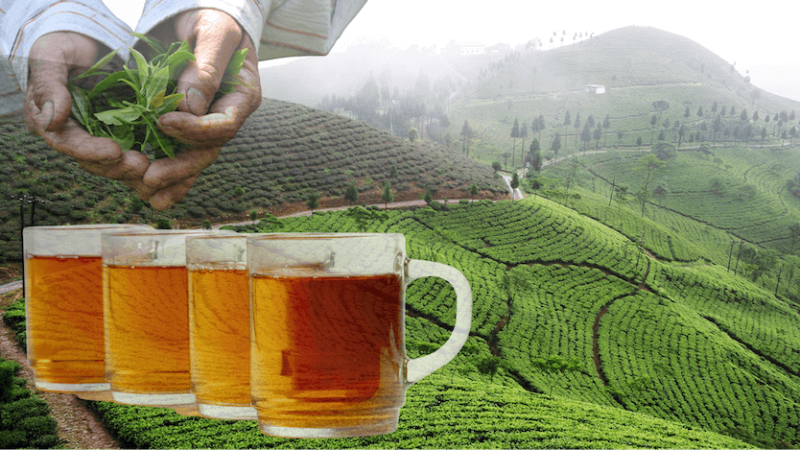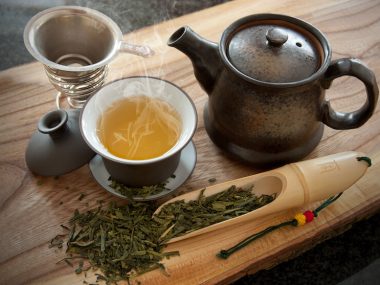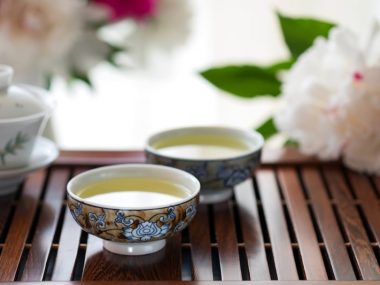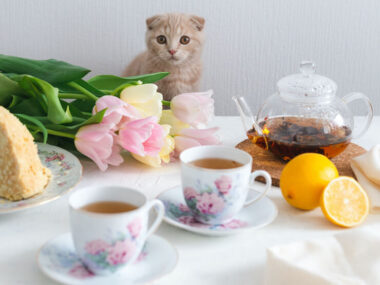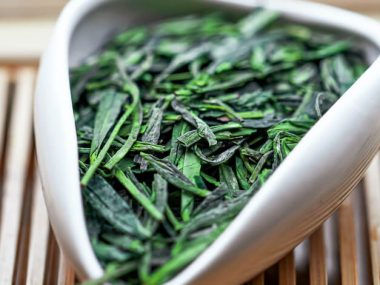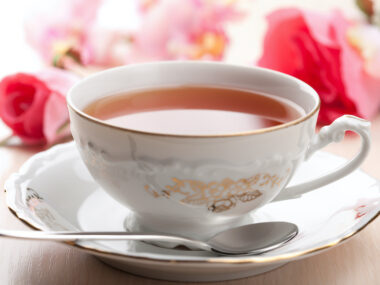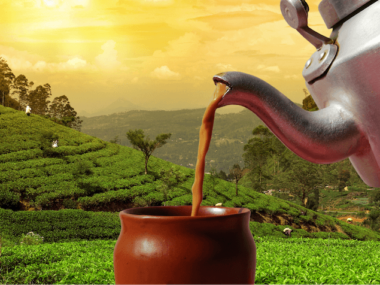Tea leaves that have been kissed and caressed by clouds come at a cost. There’s nothing cheap about Darjeeling. If gold were served up in a cup of tea, this tea would definitely be “that cup of gold,” delighting your tastebuds to the fullest!
Table of Contents
What Is Darjeeling Tea?
Darjeeling is typically a black tea that comes from one place only — the Darjeeling district in northern India. It is grown from a small-leaf Chinese cultivar called Camellia sinensis v. sinensis. To be classified as Darjeeling, this type of tea must adhere to rigorous guidelines from the moment of planting all the way to exportation.
Darjeeling rests in a mountainous area that sits in between Nepal and Bhutan. The district is extremely small and is about ¼ the size of Rhode Island. To enjoy a cup of this tea, you can’t help but have a sincere appreciation for what went into producing such a unique and fine variety!
The Rich Background Of Darjeeling
Lightning strikes Darjeeling and outlying districts often. A storm that rolled through back in May of 2018 caused 60 deaths by lightning in and around Darjeeling. The region has a confluence of colliding weather systems, which result in heavy rainfall (and lightning.) This tropical climate lends to the flourishing of the tea crops.
Ancient Tibetan Buddhists Termed “Darjeeling” as:
- “Darj” (which is “dorje”) translates to “thunderbolt”
- “Ling” translates to the “place” “land”
- Darjeeling = Place of Lightning
Hitting the rewind button back to the mid-1800s, tea makers began to see the potential for harnessing the rich soil, tropical climate, and exposure to sunlight. It was here that they began the craft of Darjeeling tea growing. Tea bushes were planted up and down the sharp inclines of mountains where clouds kissed the tea leaves. This tradition of growing tea at the highest elevation in the smallest region has been the driving force behind the uniqueness of the tea and the high cost to enjoy it.
The Varying Degrees Of Color and Flavor
Darjeeling tea has many “faces,” so to speak. The color and flavor are all dependent on what flush the tea happens to fall within and the type of tea it is (black, green, oolong, or white.)
The Flavors Of Different Types Of Darjeeling Tea
Black (the most common type of Darjeeling)
- Muscatel
- Floral
- Fruity
Green
- Grassy
- Vegetal
- Earthy
White
- Delicate
- Mild
- Sweet
Oolong
- Muscatel
Flushes Of Darjeeling Tea
Processing Darjeeling Tea
| Spring Flush (March) | Summer Flush (May-June) | Monsoon Flush (July-September) | Autumnal Flush (October) |
| Flavor Profile Delicate Floral Astringent | Flavor Profile Muscatel Fruity Floral | Flavor Profile Diluted | Flavor Profile Fruity |
Color Yellow | Color Amber | Color Dark | Color Amber, Burgundy |
| Nutrients/ Antioxidants Higher | Nutrients/ Antioxidants High | Nutrients/ Antioxidants Lower | Nutrients/ Antioxidants Low |
| Caffeine Higher | Caffeine High | Caffeine Lower | Caffeine Low |
Most sought after. | Typically used to make blends with other teas or sold as an affordable Darjeeling tea. |
Darjeeling tea is harvested through a method that is referred to as “Orthodox.” The traditional method of handpicking the leaves lends to the quality of the tea itself. Many tea connoisseurs will only drink teas harvested traditionally because of their higher quality. In many areas of Darjeeling, harvesters must endure a fine balancing act with their bodies positioned on the sharp inclines of mountains as they pick the leaves. Once their basket is full, a rope system pulls the weighted baskets up the mountain, where they are dumped into carts or trucks.
Spring is the peak season of tea leaf harvests as the first flush hits. As soon as the tea leaves arrive at the processing house, tea makers work around the clock to protect the integrity of the tea leaves. The tea leaves undergo a series of steps.
Withering
The fresh tea leaves are spread out into wooden troughs where they are allowed to dry out for about 14-18 hours.
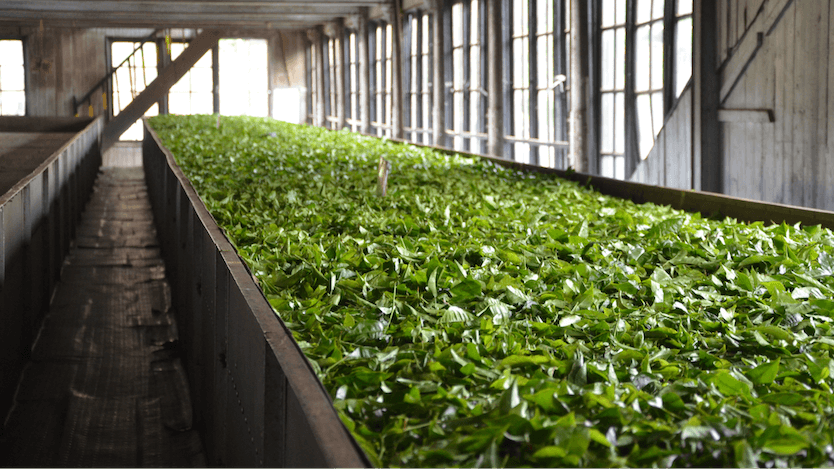
Rolling
The dried tea leaves now undergo rolling that is either done by hand or mechanically. This step twists the leaves to the desired grade. This grade ensures the cells within the leaves are rupture just enough to speed up fermentation. It takes about 20-65 minutes.
Sifting
People use large wicker trays that lift the tea leaves up into the air to sort out any unrolled leaves. This takes up to 20 minutes.
Fermentation
The sifted tea leaves are now placed on concrete platforms for up to four hours for controlled oxidation.
Drying
The tea leaves are now placed into dryers to finish drying.
Sorting and Grading
Sorters again sift out the larger tea leaves from the smaller ones. This is where the tea leaves are graded according to their size. The larger the leaf, the higher the grade, the more they cost.
Storing and Packing
The tea leaves must be stored for a certain period of time to allow them to rest. Once this is completed, they go on to be packaged and shipped.
What Is So Special about Darjeeling Tea?
Genuine Darjeeling tea is only grown in one place, and that’s a tiny district in India. This tea’s quantity is limited by the size of the district. The conditions where the tea is grown and harvested are dangerous and at times hostile because of the elevation and incline. No other tea is grown as high as Darjeeling tea!
Aside from the geographical and physical limitations that influence crop production, this tea is under tight control by the Tea Board of India (Tea Act, 1953.) To be viable as a Darjeeling tea, a certification process must be strictly followed. Growing and producing tea is held as a cultural heritage in India, and the Tea Board of India serves as a governing body that protects and preserves this heritage.
An authentic Darjeeling tea receives a logo from the Tea Board of India as the official certification that the tea has undergone the provisions and statutes as required by law. This logo is recognized as “GI” (The Geographical Indications of Goods, Registration, and Protection Act, 1999.)
Each year, there are about 40,000 tons of Darjeeling tea produced, of which 30,000 tons is counterfeit. This 30,000 tons is a mix of teas from other parts of the world that are passed off as authentic Darjeeling tea. Some have even gone as far as creating an illegal “GI” logo on their packaging, so consumers think they are getting the “real deal.”
So, in reality, there are only 10,000 tons of authentic true Darjeeling tea produced in a year’s time. This alone makes this tea very limited and rare in its own right. You can get the real Darjerleeing tea if you’re willing to pay top dollar (and possibly more) for it.
Is Darjeeling Tea High in Caffeine?
Darjeeling comes in second among the highest caffeinated tea (Assam being the first-place holder.) Research found that brewing times also affected the concentrations of caffeine. The longer you brew your tea, the higher the caffeine.
Darjeeling tea had varying levels of caffeine ranging from 14 mg to 49 mg (based on a 6 oz. serving.)
- 1-minute brew: 14-19 mg caffeine
- 3-minute brew: 22-39 mg caffeine
- 5-minute brew: 27-49 mg caffeine
Is Darjeeling Tea Good for Sleep?
Darjeeling tea is not something you want to have after 6:00 pm. The caffeine content will most definitely affect your ability to get to sleep. A cup of this tea contains about 40-50 mg of caffeine which is considered high. If you do have caffeine sensitivity and get the jitters easily, it may be in your best interest to refrain from drinking Darjeeling after 3:00 pm. Drinking tea six hours before your bedtime can reduce your sleep time by one hour.
Darjeeling Tea Benefits
Although green teas have higher health benefits, black tea such as Darjeeling has numerous benefits too. Darjeeling tea has the power to fight diabetes, cancer, high blood pressure, high cholesterol, strokes, promote a healthy heart, and help in weight loss.
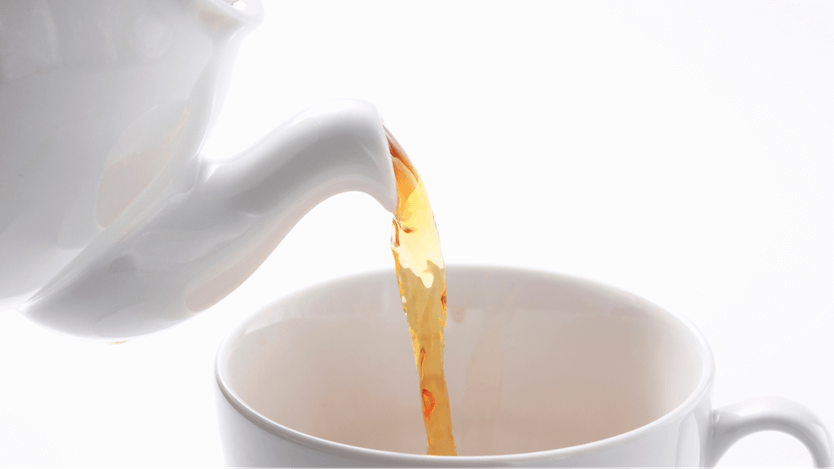
Healthy Hearts
The number one cause of death is heart attacks. The simple act of drinking Darjeeling tea daily significantly reduces cardiovascular disorders. Studies indicate that those who had three cups of black tea on a daily basis had a major improvement in antioxidants which reduced the onset of heart problems. Improvements in cholesterol levels were noted as well.
Reduces Obesity-Related Conditions
Obesity plays a big role in the onset of comorbid conditions that develop. High blood pressure, diabetes, high cholesterol, heart failure, heart attack, atherosclerosis, joint inflammation, and more occur as a result of being overweight. Polyphenols in Darjeeling tea act as an appetite suppressant and inhibit the absorption of complex sugars. They also decrease the accumulation of lipids (through reducing fat cells.) Patients in a study who consumed 4+ cups of tea daily reduced their risk of stroke. Those with diabetes who consumed black tea had a decrease in their blood sugar levels with improved insulin production.
Reduces The Risk Of Cancer
Polyphenol theaflavins in black tea were found to act against tumors. Drinking tea daily prevents the onset of cancer and inhibits the growth and regulation of cancer cells.
How To Drink Darjeeling Tea
Darjeeling tea is one of the most universal teas that pairs wonderfully with many foods. It also serves as a standalone tea to start the morning with. The astringency and tannins present in the tea should serve as a gentle guide on how you choose to enjoy Darjeeling.
Darjeeling tea superbly compliments creamy dishes, berry fruits, citrus, and mint-based foods. Desserts that go well with this tea are cheesecakes, vanilla mousse, lemon bars, strawberry shortcake, or a blueberry cobbler. Creamy soups, delicate seafood, or mint lamb go well with Darjeeling tea.
“When you pair a specific tea with a specific dish, the pairing can “unlock a third flavor.”
Jeff Ruiz, Tea Sommelier, Atera Restaurant New York City
Do You Put Milk in Darjeeling Tea?
Highly caffeinated teas are more palatable with a dash of milk or cream. The astringent taste is somewhat tamed by the sweetness found in dairy. India’s hallmark tea, Masala Chai, is a base of robust Assam or Darjeeling tea with milk added. Milk adds a whole new dimension of flavor to the tea. However, as with any other beverage, it all comes down to personal preference.
How Do I Choose a Darjeeling Tea?
Finding an authentic Darjeeling tea is similar to shopping for a high-end designer handbag. There are specific indicators that will reveal whether it’s the real deal or not. Never trust appearances because they can be deceiving. Source your tea by doing research and never trust an online retailer or website just because they seem reputable.
We have a few tips for selecting a Darjeeling tea.
- Avoid third-party sites and go straight to the tea grower. Many counterfeit tea sellers disguise themselves on eBay, Etsy, and even Amazon. Some tea retailers unknowingly sell fake Darjeelings because they have sourced their teas from third parties instead of a tea grower.
- An authentic Darjeeling tea will bear the “Geographical Indicator” Darjeeling logo. If it doesn’t have the green and white logo, it’s most likely a fake tea.
- Buy your Darjeeling tea based on the flush and flavor profile. The first (Spring) and second (Summer) flushes are best. First flushes are always going to be premium tea. Anything past the second flush is lower in quality and taste.
Here are a few reputable tea growers in Darjeeling, India, to purchase your tea directly from:
The “Best” Of The “Best”
Darjeeling tea is a tea that you don’t want to pass up and enjoy. Although it may cost a pretty penny, every sip is worth it. You can’t help but take in the hard labor and love that went into nurturing tea leaves to the moment they land in your cup!
